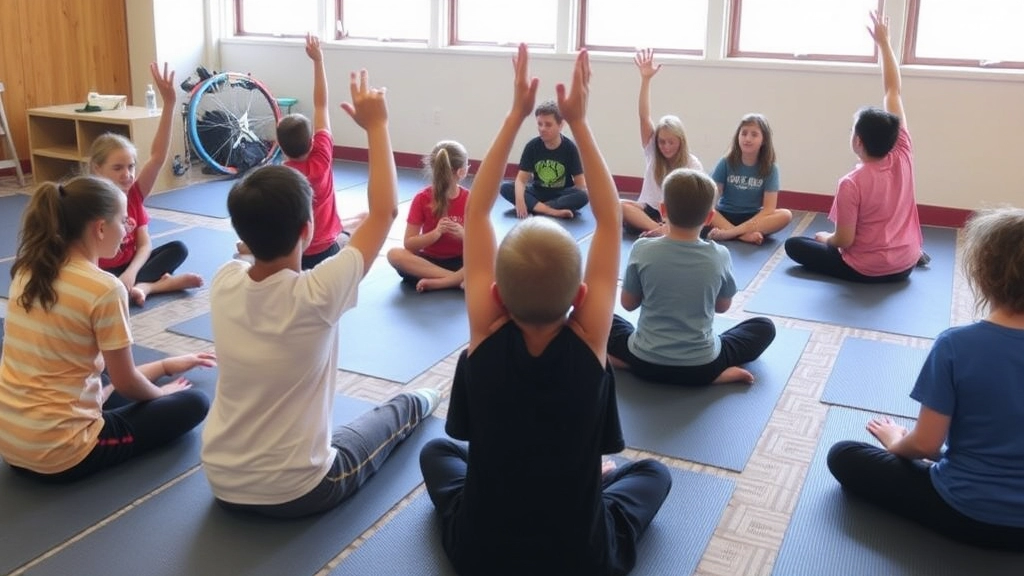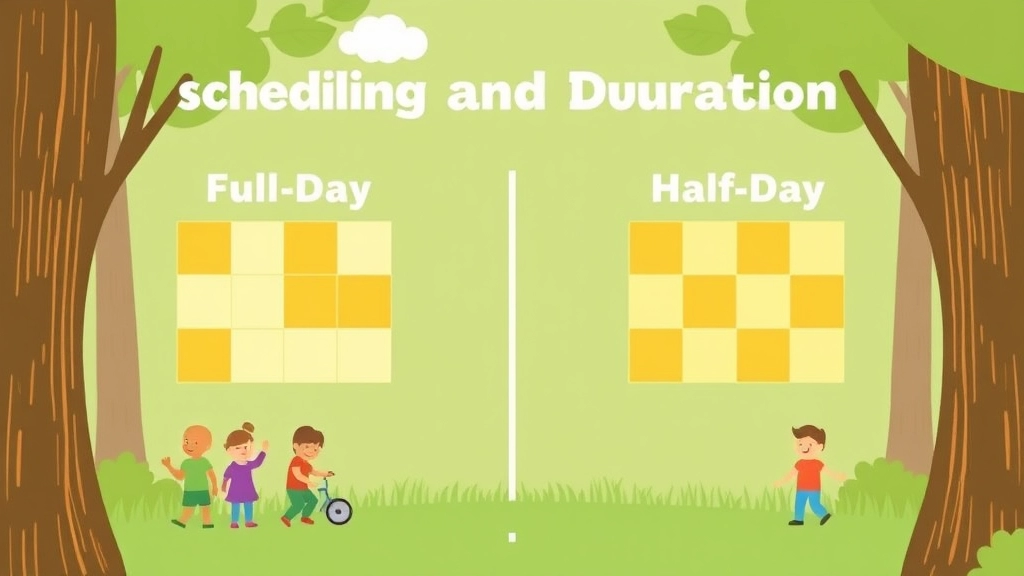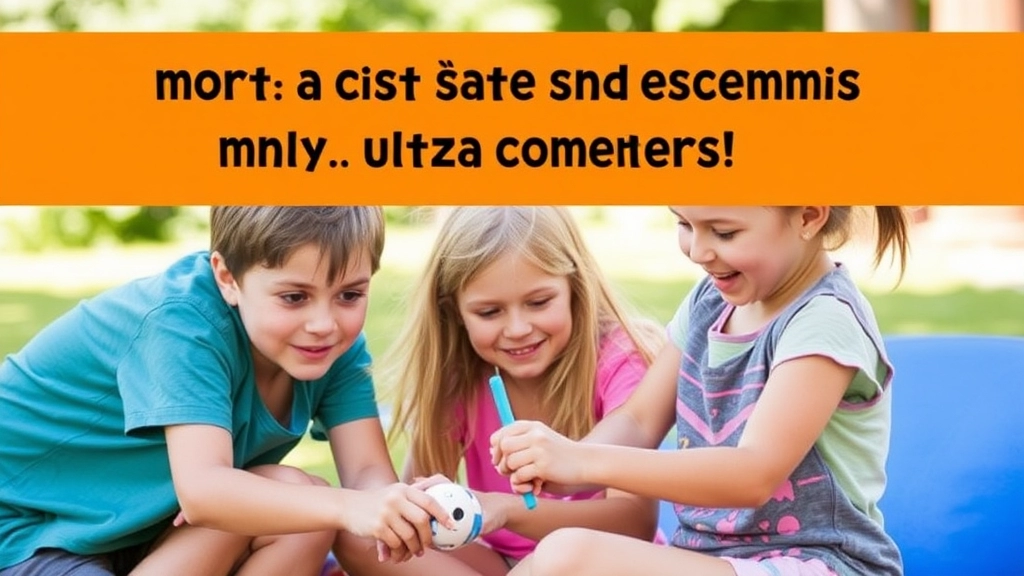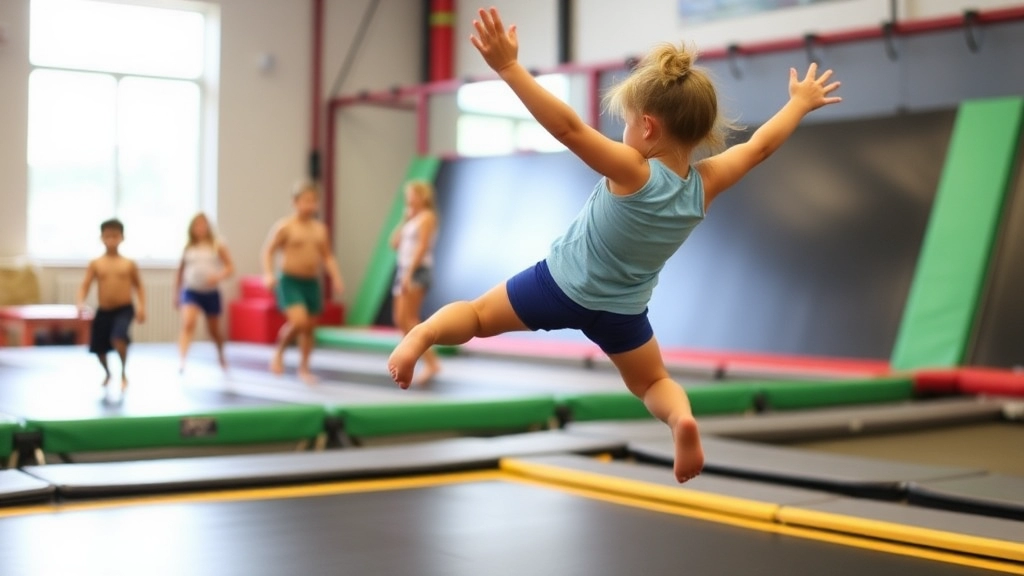Looking for the Perfect Summer Camp?
Looking for the perfect summer camp to keep your kids active and engaged? Trampoline and tumbling summer camps might be just what you need. These camps offer a fantastic way for children and teens to develop their skills in a fun and structured environment. From beginners to competitive levels, there’s something for everyone.
Benefits of Trampoline and Tumbling Summer Camps
At trampoline and tumbling summer camps, your child will not only improve their fitness and agility but also enjoy a variety of other activities like arts, crafts, and games. Safety is a top priority, with certified coaches ensuring a secure and supportive atmosphere.
Flexible Scheduling
Whether you’re looking for full-day or half-day options, these camps provide flexible scheduling to fit your needs. Ready to jump in? Learn more about the best camps and how to register today!
What to Expect from Trampoline and Tumbling Summer Camps
Alright, let’s cut to the chase. You’re probably wondering, “What’s the big deal about trampoline and tumbling summer camps?” Well, let me break it down for you. These camps are not just about jumping around and doing flips. They’re about building confidence, improving physical fitness, and most importantly, having a blast.
The Basics: What Happens at These Camps?
Trampoline and tumbling camps are designed to teach kids the fundamentals of the sport while ensuring they have a great time. Expect a mix of structured training sessions and free time to explore and play. Here’s a quick rundown of what typically goes down:
- Skill Development: From basic jumps to advanced flips, campers learn a variety of moves.
- Strength and Conditioning: Exercises to build core strength, flexibility, and overall fitness.
- Safety Training: Learning how to jump and land safely is a big part of the curriculum.
- Team Building Activities: These camps often include games and activities that promote teamwork and camaraderie.
Real Talk: What Are Parents Worried About?
I get it. Sending your kid off to camp can be nerve-wracking. Here are some common concerns:
- Safety: “Will my child get hurt?” Camps have strict safety protocols, and coaches are trained to prevent injuries.
- Skill Level: “What if my child is a complete beginner?” Camps cater to all skill levels, from newbies to competitive athletes.
- Fun Factor: “Will my kid actually enjoy this?” Trust me, the mix of activities keeps it engaging and fun.
Why Choose Trampoline and Tumbling Camps?
Let’s be real, kids have endless energy. Trampoline and tumbling camps provide a constructive outlet for this energy. Plus, the skills they learn go beyond the mat. They gain confidence, discipline, and a sense of achievement.
Key Takeaways:
- Structured Learning: Camps offer a balanced mix of training and fun.
- Safety First: Coaches are certified, and safety protocols are in place.
- All Skill Levels: Whether your kid is a beginner or a seasoned tumbler, there’s something for everyone.
If you’re looking for a comprehensive guide to prepare for camp, check out our Summer Camp Checklist. For those interested in other exciting camp options, our Top Summer Drum Camps might be worth exploring.
Types of Programs Offered: From Beginner to Competitive Levels

So, you’re thinking about sending your kid to a trampoline and tumbling summer camp, right?
But what kind of programs do they offer?
Let’s break it down.
Beginner Programs
First up, beginner programs.
These are perfect if your child is new to the world of trampolines and tumbling.
Here’s what you can expect:
- Basic Skills: Learning the fundamentals like jumping, flipping, and basic tumbling.
- Safety First: Emphasis on safety protocols to prevent injuries.
- Fun Games: Engaging activities to keep the kids entertained and excited.
Intermediate Programs
Got a kid who already knows their way around a trampoline?
Intermediate programs might be the way to go.
These camps focus on:
- Advanced Techniques: Building on basic skills with more complex moves.
- Strength Training: Incorporating exercises to build strength and flexibility.
- Routine Practice: Starting to put together simple routines.
Competitive Levels
For the ambitious ones, there are competitive level programs.
These are intense, but if your child is serious about trampolining, they’ll love it.
Expect:
- High-Level Coaching: Training from coaches with competitive experience.
- Routine Perfection: Fine-tuning routines for competitions.
- Mental Preparation: Techniques to handle the pressure of competitions.
Specialised Programs
Some camps also offer specialised programs focusing on specific skills or types of tumbling.
These might include:
- Power Tumbling: High-intensity tumbling over longer distances.
- Double Mini-Trampoline: Skills on smaller trampolines.
- Synchronized Trampolining: Working in pairs to perform routines.
Why It Matters
Choosing the right program is crucial.
It can make or break your child’s experience.
So, whether they’re just starting out or aiming for the stars, there’s a program that fits their needs.
Trust me, finding the right fit will make all the difference.
And hey, if you’re still not sure, many camps offer trial sessions.
Give it a go and see where your child fits best.
Age Groups and Skill Levels Catered by the Camps
Alright, let’s talk about one of the most crucial aspects of trampoline and tumbling summer camps: the age groups and skill levels they cater to. You’ve got questions, and I’ve got answers. So, who exactly are these camps for?
Tailored for Every Age Group
First things first, these camps aren’t a one-size-fits-all deal. They’re designed to cater to a wide range of age groups:
- Young Jumpers (Ages 5-7): Perfect for the little ones who are just getting started. Think of it as an introduction to the world of trampolining.
- Junior Tumblers (Ages 8-12): This is where kids start to get a bit more serious. They learn basic skills but in a fun, engaging way.
- Teen Trampolinists (Ages 13-17): For those who have some experience and want to take it up a notch. This group often includes more advanced training and skill development.
Skill Levels: From Beginners to Pros
Now, let’s break down the skill levels. These camps are designed to meet your child exactly where they are in their trampoline journey:
- Beginner Level: No prior experience? No problem. This level focuses on the basicsâbalance, coordination, and simple jumps.
- Intermediate Level: For those who know the basics and are ready to learn more complex moves. Think flips, twists, and combinations.
- Advanced Level: This is for the serious athletes. If your child is eyeing competitions, this is where they’ll hone their skills and perfect their routines.
Real-Life Example
Let me share a quick story. I remember chatting with a parent whose 10-year-old son, Tim, was a bit hesitant about joining a trampoline camp. He had some basic skills but wasn’t sure if he’d fit in. The camp assessed his abilities and placed him in the intermediate group. By the end of the summer, Tim was nailing flips and even considering joining a competitive team. The right camp can make all the difference.
How Camps Assess Skill Levels
Worried about whether your child will be placed in the right group? Most camps have a foolproof system for this:
- Initial Assessment: On the first day, coaches conduct a simple assessment to gauge each child’s skill level.
- Ongoing Evaluation: Coaches continuously monitor progress and can move kids between groups if needed.
- Personalised Feedback: Regular feedback sessions ensure that your child is always on the right track.
Why This Matters
Choosing a camp that caters to your child’s specific age and skill level is crucial. It ensures they’re not only safe but also challenged appropriately. Plus, it keeps them engaged and excited about learning new skills. For more tips on providing a stress-free camp experience, check out our Top 10 Summer Camp Hacks. And if you’re curious about how much you might need to budget, our Comprehensive Guide on Summer Camp Costs can help you plan ahead.
Fun Beyond the Mat: Other Activities Available at Camps

Ever wondered what else your kiddo can get up to at a trampoline and tumbling summer camp?
You’re not alone.
Parents often ask, “What if my child gets bored of just bouncing around?”
Well, let me tell you, these camps are way more than just trampolines and tumbling mats.
Beyond the Bounce: Diverse Activities Await
Yes, the main attraction is the trampoline and tumbling, but there’s a whole lot more packed into these camps.
Here’s a sneak peek:
- Arts and Crafts: Perfect for a creative break. Think painting, drawing, and even some DIY projects.
- Team Sports: Football, basketball, or even a friendly game of tag. Keeps the energy high and the fun rolling.
- Swimming: Many camps have access to pools. Great for cooling down after an intense session on the mat.
- Nature Walks: Explore the great outdoors. It’s a fantastic way for kids to unwind and connect with nature.
- Dance and Music: From hip-hop to ballet, these sessions let kids groove to the beat and express themselves.
Real-Life Example: Jack’s Summer Camp Experience
Let’s talk about Jack.
He’s 10, loves trampolines but also has a knack for painting.
At camp, he spent mornings mastering new flips, and afternoons creating masterpieces in the arts and crafts corner.
By the end of summer, he had a new set of skills and a bunch of new friends.
Why These Activities Matter
You might be wondering, “Why all these extra activities?”
Simple.
Kids need variety.
It keeps them engaged and excited.
Plus, it gives them a chance to discover new interests and talents.
Safety Protocols and Certifications of Coaching Staff
Are You Worried About Safety at Trampoline and Tumbling Camps?
Let’s be real. As a parent, the thought of your child bouncing around on a trampoline can be nerve-wracking. You might be asking yourself, “Is it safe?” or “Are the coaches qualified?” These are valid concerns, and I’m here to put your mind at ease.
Why Safety Protocols Matter
Safety isn’t just a buzzword; it’s the backbone of any good trampoline and tumbling camp. Knowing that your child is in a secure environment is crucial for peace of mind. Here’s what you need to know about the safety protocols at these camps:
- Regular Equipment Checks: Camps conduct daily inspections to ensure all trampolines and tumbling mats are in top-notch condition.
- Emergency Preparedness: First-aid kits are always on hand, and staff are trained to handle injuries promptly and effectively.
- Safety Rules and Guidelines: From the moment your child steps into the camp, they’ll be briefed on safety rules. This includes everything from how to land safely to what to do in case of an emergency.
Certifications of Coaching Staff: Why It Matters
Now, let’s talk about the coaching staff. You don’t want just anyone teaching your child how to flip and tumble. Here’s what you should look for in a qualified coach:
- Certified Coaches: Look for coaches with certifications from reputable organisations like British Gymnastics or USA Gymnastics. These certifications ensure that the coaches are well-versed in safety protocols and teaching techniques.
- First Aid Training: All coaches should have up-to-date first aid and CPR certifications. This is non-negotiable.
- Experience Matters: While certifications are essential, experience is equally important. Coaches with years of experience bring a level of expertise that can’t be taught in a classroom.
Real-Life Example: How One Camp Prioritises Safety
Take, for instance, the XYZ Trampoline and Tumbling Camp. They not only have certified coaches but also a stringent safety protocol. Every morning starts with a safety briefing, and coaches are always on the floor, ensuring that every flip and tumble is executed safely. Parents have consistently praised the camp for its commitment to safety, making it one of the most trusted camps in the area.
Your Peace of Mind
At the end of the day, knowing that your child is in safe hands allows you to relax and enjoy your summer too. Safety protocols and certified coaching staff are not just features; they are the foundation of any reputable trampoline and tumbling camp.
So, when you’re looking at camps, make sure to prioritise these aspects. Your child’s safety is worth every minute of research. For more tips on ensuring a safe camp experience, check out our PSA Summer Camps guide. You may also find our Effective Summer Camp Staff Training article helpful for understanding the best practices in staff training.
Scheduling and Duration Options: Full-Day vs. Half-Day Camps

Alright, let’s talk about the nitty-gritty: scheduling and duration options for trampoline and tumbling summer camps.
You’ve got two main choices here: full-day and half-day camps.
But which one is right for your kid?
Full-Day Camps
Full-day camps are like the marathon of summer camps.
They typically run from around 9 AM to 4 PM.
Here’s what you can expect:
- More training time: Your kid will get more hours on the trampoline, honing their skills.
- Extra activities: Beyond the mat, there might be arts and crafts, team-building exercises, and even some pool time.
- Lunch and snacks: Most full-day camps provide meals, so you don’t have to worry about packing lunch.
Half-Day Camps
Half-day camps are the sprinters.
They usually run for about 3-4 hours, either in the morning or afternoon.
What’s the deal with half-day camps?
- Focused training: Less time, but often more intense and focused.
- Flexibility: Perfect if your kid has other commitments or if you just want to dip your toes into the camp experience.
- Cost-effective: Generally cheaper than full-day camps, making it easier on the wallet.
Real Talk: Which One to Choose?
I get it, deciding between full-day and half-day camps can be a headache.
Here are some questions to help you out:
- How old is your child? Younger kids might not have the stamina for a full day.
- What’s their skill level? Advanced athletes might benefit from the extended training of a full-day camp.
- What’s your schedule like? If you need childcare while you’re at work, a full-day camp is a lifesaver.
My Personal Take
When I was a kid, I started with half-day camps.
It was a great way to get my feet wet without feeling overwhelmed.
As I got more into it, I transitioned to full-day camps to really level up my skills.
Tips for Choosing the Right Camp for Your Child
Alright, so you’re thinking about enrolling your child in a trampoline and tumbling summer camp. Great choice! But how do you make sure you pick the right one? Let’s break it down.
What Are Your Child’s Interests and Goals?
First things first, what does your child want out of this camp? Are they looking to have fun, make friends, or seriously up their game? Knowing their goals will help you pick a camp that aligns with their interests.
- Fun and Recreation: If your kid just wants to bounce around and have a blast, look for camps that offer a variety of activities and a relaxed atmosphere.
- Skill Improvement: For those who want to get better at trampoline and tumbling, find a camp with a structured program focusing on technique and skill-building.
- Competitive Edge: If your child is aiming to compete, you’ll want a camp that offers advanced training and possibly even has connections to competitive leagues.
Check the Camp’s Reputation
You wouldn’t buy a car without reading reviews, right? Do the same for camps.
- Read Reviews: Look for feedback from other parents and kids. Websites, social media, and even word of mouth can be gold mines for honest opinions.
- Visit the Camp: If possible, take a tour. See the facilities, meet the staff, and get a feel for the environment.
Safety First
Safety is non-negotiable. Ask about their safety protocols and make sure they’re up to snuff.
- Certified Coaches: Ensure the coaching staff is certified and experienced. Certifications like USAG (USA Gymnastics) are a good sign.
- Emergency Plans: Ask about their emergency procedures and first aid protocols. Better safe than sorry.
Consider the Schedule and Duration
Does the camp schedule fit into your summer plans? Think about the logistics.
- Full-Day vs. Half-Day: Full-day camps offer more training and activities but can be exhausting. Half-day camps are less intense but might not cover as much ground.
- Session Length: Some camps run for a week, others for the whole summer. Pick what works best for your family’s schedule.
Budget Matters
Camps can get pricey, so make sure you know what you’re getting for your money.
- Cost: Compare prices of different camps. Sometimes, the most expensive isn’t necessarily the best.
- Discounts: Look for early bird discounts, sibling discounts, or package deals. Every little bit helps.
Extra Activities
Does the camp offer more than just trampoline and tumbling? Variety can keep your child engaged and make the experience more enjoyable.
- Other Sports: Some camps offer additional sports or activities like swimming, arts and crafts, or team-building exercises.
- Field Trips: Camps that include outings or special events can add an extra layer of fun.
Trust Your Gut
Finally, trust your instincts. If something feels off, it probably is. The right camp should feel like a good fit for both you and your child.
For more information on specialized camps, check out our AI Summer Camps and the Top Summer Camps for Horseback Riding Adventures.
Cost and Discounts for Summer Camps

Alright, let’s talk money. How much is this going to set you back?
Cost of Summer Camps: What to Expect
When it comes to trampoline and tumbling summer camps, prices can vary quite a bit.
Here’s what you need to know:
- Beginners’ Camps: Usually, these are the least expensive. You might be looking at around £100-£200 for a week-long camp.
- Intermediate Camps: These camps often cost a bit more, somewhere in the range of £200-£400.
- Competitive Camps: If your kid is really into it, these camps can go up to £500 or more for a week.
Discounts and Deals: How to Save
Everyone loves a good deal, right? Here are some ways to save on these camps:
- Early Bird Discounts: Sign up early and you might snag a discount of 10-20%.
- Sibling Discounts: Got more than one kid? Many camps offer discounts if you sign up siblings.
- Referral Bonuses: Some camps give you a discount if you refer a friend who signs up.
- Multi-Week Discounts: Planning to send your child for more than one week? Camps often offer reduced rates for multiple weeks.
Real Talk: Is It Worth It?
You might be wondering if spending this kind of money on a summer camp is worth it.
Here’s the deal:
- Skill Development: These camps are fantastic for improving skills.
- Fun Factor: Let’s be real, your kid is going to have a blast.
- Social Skills: Meeting new friends and learning to work as a team? Priceless.
A Quick Recap:
- Costs can range from £100 to £500 depending on the camp level.
- Look out for early bird, sibling, referral, and multi-week discounts.
- The investment is worth it for the skills, fun, and social benefits.
So, ready to get your kid bouncing and flipping this summer? Make sure to check out the discounts and save where you can.
How to Register: Securing a Spot at a Popular Trampoline Camp
Alright, so you’re thinking about getting your kid into a trampoline and tumbling summer camp, but you’re worried about how to actually secure a spot.
It can be a real headache, right?
Let’s break it down.
Why Is It So Tough to Get In?
First off, these camps are popular.
Parents know they’re a great way to keep kids active and entertained.
Spots fill up fast.
So, how do you make sure your kid gets in?
Step-by-Step Guide to Registering
- Start Early
- Camps usually open registration months in advance.
- Mark your calendar.
- Sign up for newsletters or alerts from the camp’s website.
- Do Your Research
- Check out different camps.
- Look at reviews.
- Compare what they offer and their schedules.
- Prepare the Necessary Info
- Have your child’s details ready: age, skill level, any medical info.
- Some camps may require a skill assessment or previous experience.
- Registration Day
- Be ready to go online the moment registration opens.
- Have your payment method ready.
- Fill out forms quickly but accurately.
Pro Tips to Boost Your Chances
- Join a Waitlist: If you miss out, don’t panic. Many camps have waitlists.
- Network: Talk to other parents. Sometimes they have insider tips on getting in.
- Follow Up: If you’re on a waitlist, check in periodically. Spots can open up.
Common Mistakes to Avoid
- Procrastinating: Waiting until the last minute is a no-go.
- Ignoring Deadlines: Camps have strict deadlines for a reason.
- Incomplete Forms: Double-check everything before hitting submit.
Why It’s Worth It
Yes, it can be stressful, but imagine your kid having a blast, learning new skills, and making friends.
Totally worth the effort, right?
For more information on the best summer camps, check out our top summer camps for 14-year-olds and our ultimate guide to choosing a cheer summer camp.
FAQs about Trampoline and Tumbling Summer Camps
What types of programs are available at trampoline and tumbling summer camps?
Camps offer a variety of programs tailored to different skill levels:
- Beginner Programs: Focus on basic skills, safety, and fun activities.
- Intermediate Programs: Emphasize advanced techniques, strength training, and routine practice.
- Competitive Levels: Provide high-level coaching and preparation for competitions.
- Specialised Programs: Include power tumbling, double mini-trampoline, and synchronized trampolining.
What other activities are available at these camps?
In addition to trampoline and tumbling, camps often include:
- Arts and Crafts: Creative activities like painting and drawing.
- Team Sports: Games like football and basketball.
- Swimming: Access to pools for cooling down.
- Nature Walks: Exploring the outdoors.
- Dance and Music: Sessions for dancing and musical expression.
What are the scheduling and duration options for these camps?
Camps typically offer two main options:
- Full-Day Camps: Run from around 9 AM to 4 PM, offering more training time and additional activities.
- Half-Day Camps: Last about 3-4 hours, either in the morning or afternoon, and are more focused and flexible.
How much do trampoline and tumbling summer camps cost?
Costs vary depending on the level of the camp:
- Beginners’ Camps: Around £100-£200 per week.
- Intermediate Camps: Approximately £200-£400 per week.
- Competitive Camps: Can go up to £500 or more per week.
Are there any discounts available?
Yes, many camps offer discounts:
- Early Bird Discounts: Save 10-20% by signing up early.
- Sibling Discounts: Discounts for signing up multiple children.
- Referral Bonuses: Discounts for referring friends who sign up.
- Multi-Week Discounts: Reduced rates for multiple weeks.
Is it worth investing in these summer camps?
Absolutely. The benefits include:
- Skill Development: Significant improvement in trampoline and tumbling skills.
- Fun Factor: Kids have a great time.
- Social Skills: Opportunities to make new friends and learn teamwork.
Ready to get your kid bouncing and flipping this summer? Look out for discounts and choose the best program for their needs!
References
-
Best Summer Camps for Kids
-
Trampoline Camps
-
Trampoline Central: Trampoline Camps

